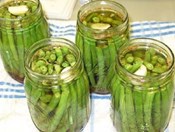Many people are returning to home canning or joining the movement for the first time. However, many are making a mistake that can be deadly: canning their green beans and other vegetables in boiling water instead of under pressure with a properly researched procedure. In the past two years, there have been at least 3 events of botulism poisoning from improperly processed home canned green beans.
Canning low-acid vegetables, meats, fish and poultry requires the use of a pressure canner. Spores of Clostridium botulinum bacteria, as found naturally in soils, are very, very heat resistant. Even hours in the boiling water canner will not kill them if they are inside your jars of beans. Left alive after canning, they will eventually germinate into actively growing bacterial cells that will produce a deadly human toxin when consumed. The bacteria like the conditions inside closed jars of low-acid foods (such as vegetables and meats) sitting at room temperature, so they must be killed during the canning process for safe storage.
Jars of improperly canned vegetables and meats can contain the deadly botulism toxin without showing signs of spoilage. People who see their beans spoiling after underprocessing them (not using enough heat when canning them) may also have jars that contain botulism toxin because they are showing signs of underprocessing by other spoilage that might include cloudy, bubbling liquid and jars that pop open after initially sealing.
There are two types of pressure canners available: a dial gauge type and a weighted gauge type. Dial gauge canners use a dial to indicate or show the pressure inside the canner. It is necessary to have the dial gauge tested for accuracy before each canning season or after dropping or banging it. Your county Extension agent or a local hardware store should be able to provide you with information on having a dial gauge tested. There are several styles of weighted gauge canners in the marketplace; these have weights on the open vents that let you choose 5, 10 or 15 pounds pressure for processing.
To use the USDA canning procedures, make sure you select a pressure canner/cooker that is capable of holding at least 4 quart size jars, on the rack, with the lid in place ready to can. If it is smaller than that, we do not recommend it for home canning. Also make sure all parts of your pressure canner are in good condition. If your canner has a rubber gasket, make sure it is flexible and soft, not brittle, sticky or cracked. Also, check the openings on any small pipes or ventports to be sure they are clean and clear of any debris.
Altitude adjustments for processing are very important for safety and can be found with our printed procedures or should be with your manufacturer’s instructions. Pressure canners should also have the air vented from them for 10 minutes of boiling before you pressurize the canner. Read more about this step and other step-by-step procedures for using pressure canners: http://www.uga.edu/nchfp/publications/uga/using_press_canners.html
If your pressure canner has not yet been used this season or is new out of the box, it is a good idea to make sure it is working properly before preparing a canner load of jars. Put several inches of water in your pressure canner, and pressurize it as if canning. Make sure it gets to the pressure needed and can be maintained there without leaking. This is a good time to practice de-pressurizing the canner as if it had jars in it and then go through the steps for opening your canner as desired.
Using up-to-date canning instructions from a reliable source is essential. Scientific knowledge and equipment have changed since earlier generations were canning foods at home. People using boiling water canners or not using pressure canners correctly that did not have their food spoil or make them sick were just lucky. You might not be so lucky and the reality is that you could end up with botulism poisoning or at the least, throwing out a lot of spoiled food. See the USDA home canning procedures at the National Center for Home Food Preservation website at www.uga.edu/nchfp/.
If you have already Jars that are known to be spoiled or known to be underprocessed even without showing obvious signs of spoilage, they should be treated as if they contain botulism toxin. See information about discarding sealed jars or detoxifying jars that have opened here: http://www.uga.edu/nchfp/how/general/identify_handle_spoiled_canned_food.html
Source: Elizabeth L. Andress, Ph.D.Professor and Extension Specialist, University of Georgia, National Center for Home Food Preservation, homefoodpreservation.com June 2010







